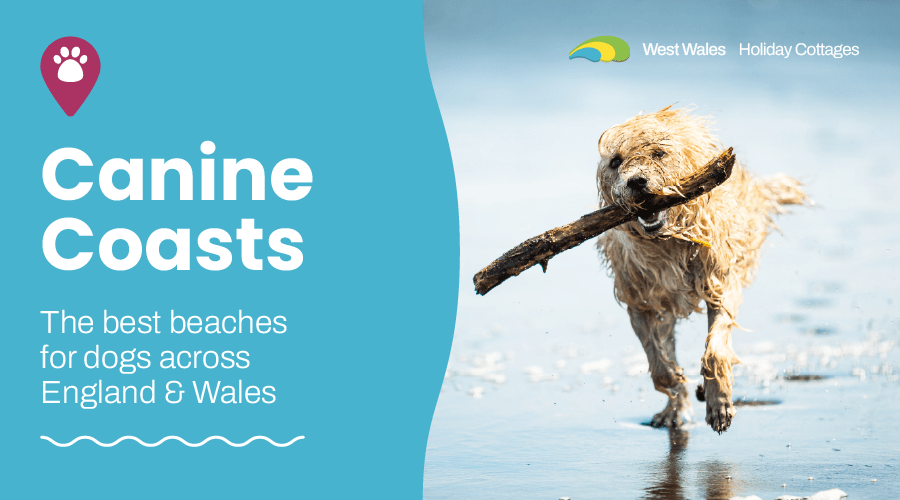
For those who love to be near the beach and also want to share that joy with their four-legged friends, England and Wales have plenty of options. A dog-friendly holiday is a perfect way to escape the daily grind and spend quality time with your furry friend. Booking a coastal holiday cottage is one of the best options for dog-friendly holidays, as they usually allow pets, making your stay comfortable and convenient.
But which beaches around England and Wales are the best for dog owners? To find out, we’ve compared some of the best beaches in each on factors such as whether dogs are allowed, the number of dog-friendly establishments in the area, the weather, and more.
The best Welsh beaches for dogs
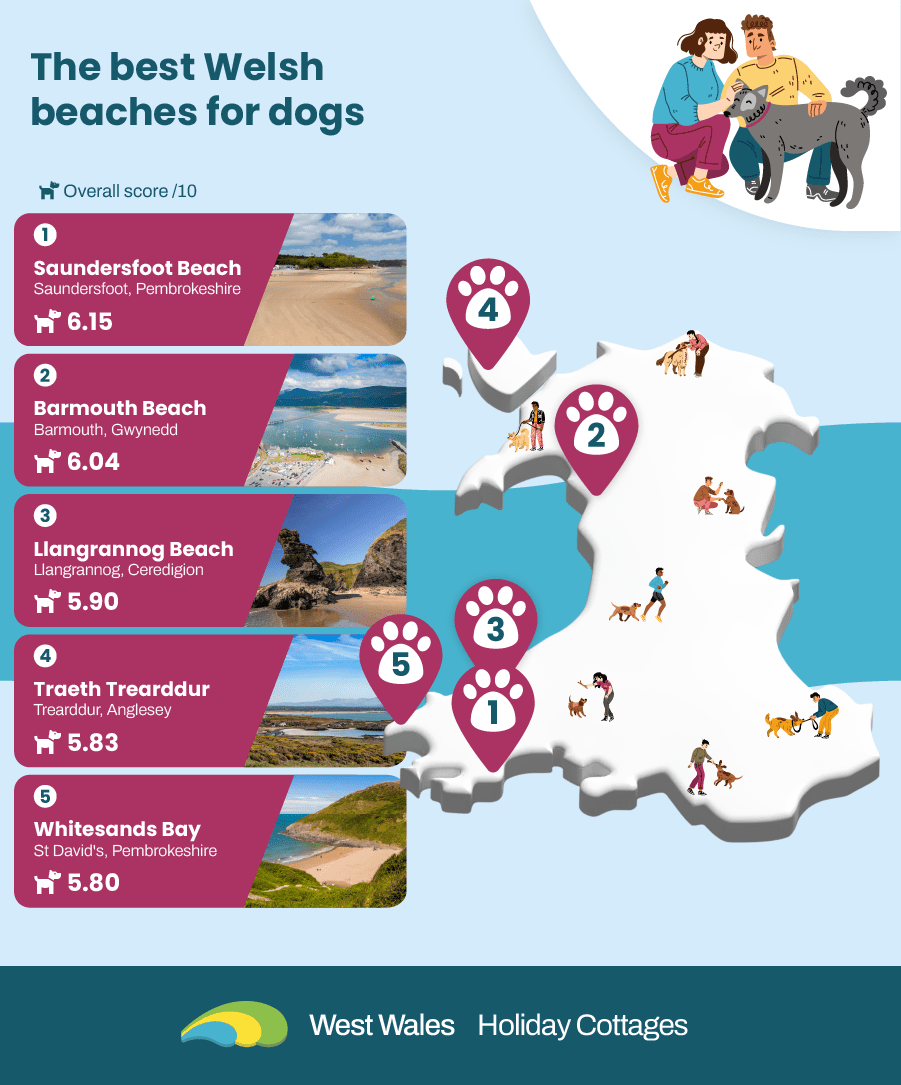
1. Saundersfoot Beach, Pembrokeshire – 6.15
Saundersfoot Beach tops the list in Wales with an overall score of 6.15 out of 10. The beach comes with a strong review score of 4.7 out of 5. In the summer months, there are a few dog restrictions; however, your furry friends are always allowed in the area before Coppet Hall Beach. Two-thirds of Saundersfoot’s accommodation listings also allow pets, and over a quarter of restaurants are dog-friendly.
2. Barmouth Beach, Gwynedd – 6.04
Barmouth Beach comes in close second, boasting an “excellent” water quality rating and 77% of accommodation options in the town allow pets. It also has a high review score among those to have visited, at 4.8 and has clocked up over 18,000 posts on Instagram.
3. Llangrannog Beach, Ceredigion – 5.90
Llangrannog Beach comes in third with a score of 5.90. Like Barmouth, the water quality is rated “excellent”, although it’s slightly warmer and drier here, averaging 10.1°C and 1,282mm of rainfall. Llangrannog also has the highest rate of dog-friendly accommodation properties, at 83% and 50% of restaurants and places to eat are also dog-friendly.
4. Traeth Trearddur, Anglesey – 5.83
Fourth place goes to Traeth Trearddur, with an overall score of 5.83. This beach in Anglesey has a water quality rating of “excellent” and has a very high rating of 4.8 out of 5 with visitors. It’s among the island’s most popular beaches and has an average temperature of 10.9°C, the highest in the top five.
5. Whitesands Bay, Pembrokeshire – 5.80
Whitesands Bay is the fifth Welsh beach on the list, located in the picturesque area of St David’s in Pembrokeshire. The beach excels in its water quality with an “Excellent” rating. If you’re planning a visit, you’ll also find a reasonable number of dog-friendly establishments in Whitesands, making it a balanced choice for dog owners.
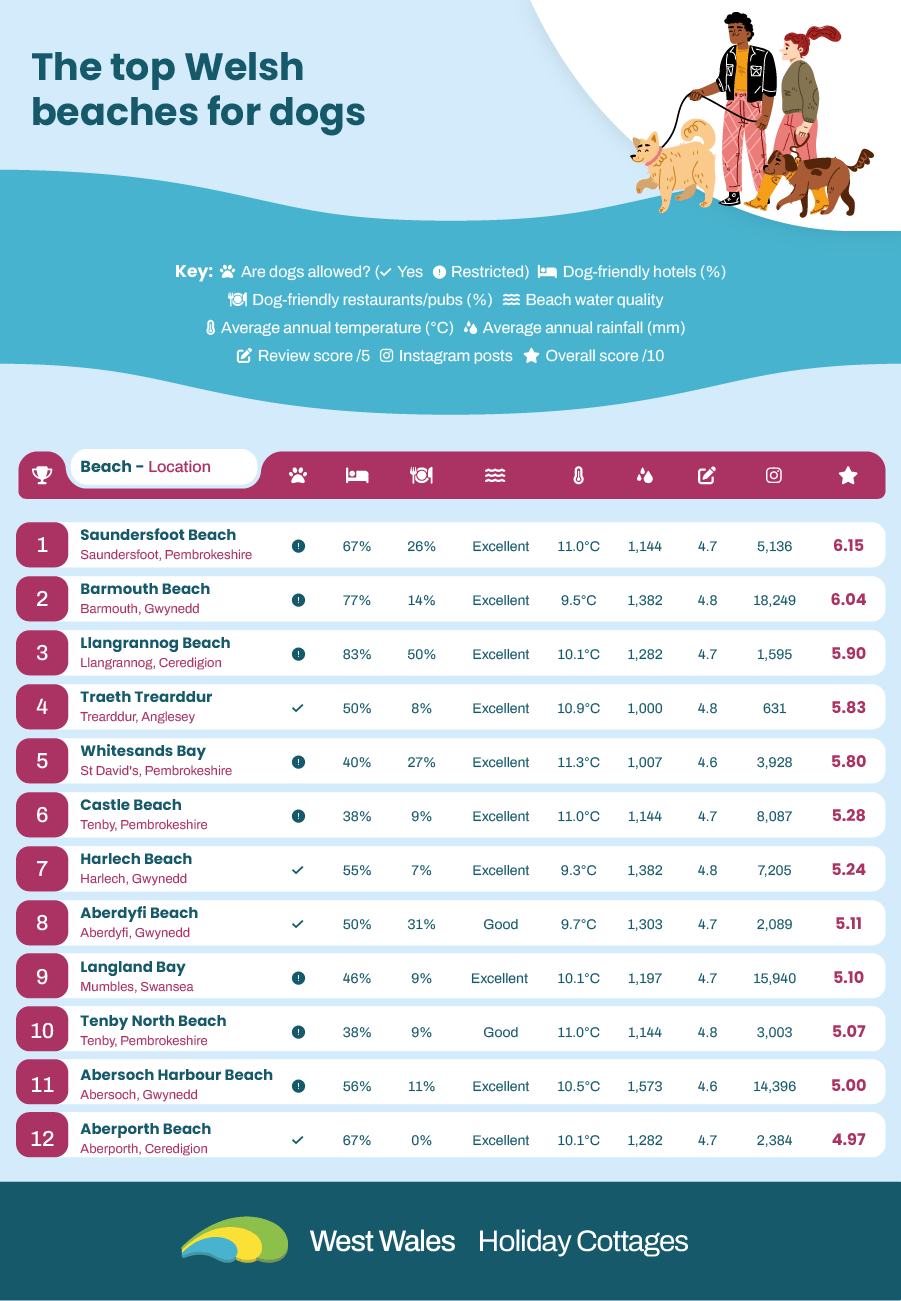
The best English beaches for dogs
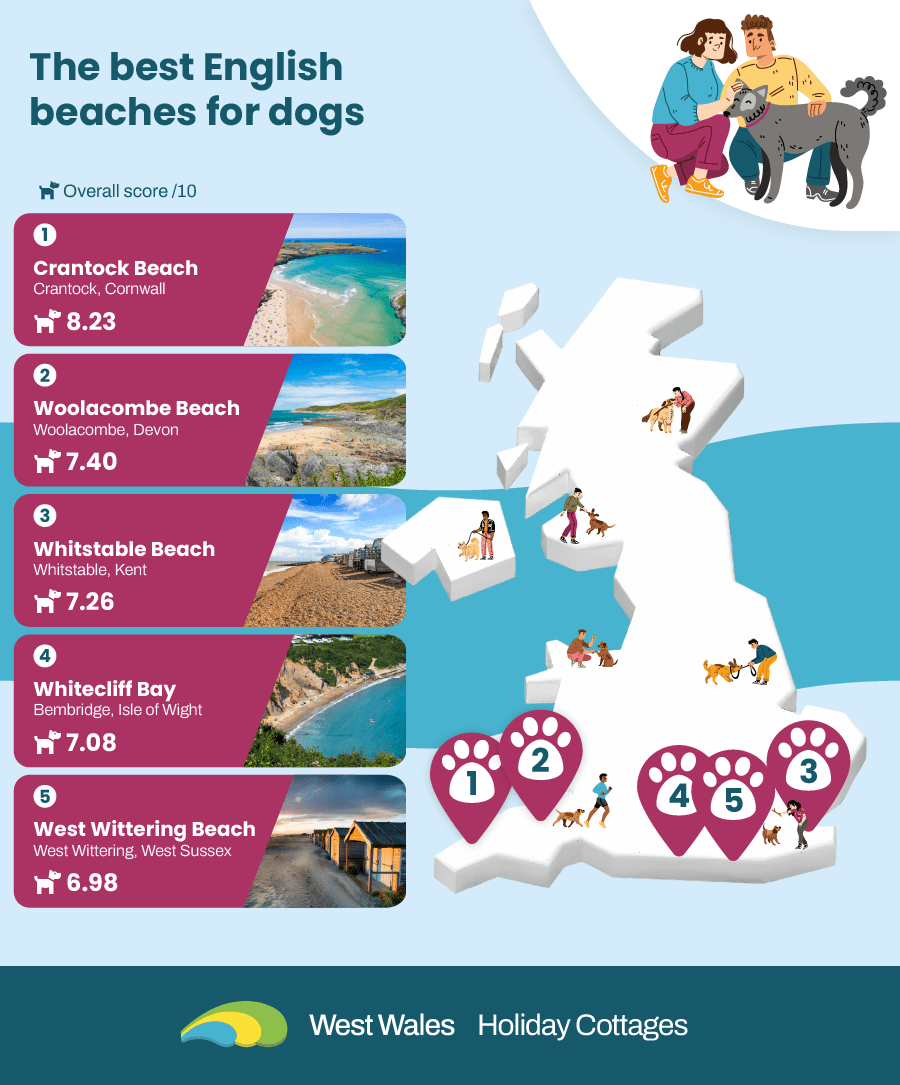
1. Crantock Beach, Cornwall – 8.23
Crantock Beach tops the list with an overall score of 8.23. It offers a balanced experience, featuring a good beach environment and a relatively high number of dog-friendly accommodation options and restaurants. Located in the picturesque Cornish village of Crantock, this beach offers a great blend of natural beauty and convenience for dog owners.
2. Woolacombe Beach, Devon – 7.40
Second-placed Woolacombe Beach is a haven for surfers, families, and dog owners. While dogs have restricted access, the beach is still reasonably dog-friendly in terms of accommodation and restaurants and offers excellent water quality. The Devon coast offers a scenic backdrop for all beachgoers, providing a sense of escape and relaxation.
3. Whitstable Beach, Kent – 7.26
Whitstable Beach in Kent comes third on the list. It was one of the beaches to rank as “Excellent” for its water quality, but it also has low rainfall and is one of the most Instagrammable beaches. Whitstable is a charming seaside town known for its seafood, making it a perfect spot for a day trip or a more extended stay.
4. Whitecliff Bay, Isle of Wight – 7.08
Whitecliff Bay on the Isle of Wight takes fourth place, scoring 7.08 out of 10. It’s the best-reviewed beach on the list, with an average score of 4.9 out of 5. It also boasts excellent water quality, and a quarter of restaurants and places to eat are dog-friendly.
5. West Wittering Beach, West Sussex – 6.98
West Wittering Beach is another beach where dogs are only allowed at certain times of the year, but it makes up for this with its number of dog-friendly establishments. Located in West Sussex, this beach offers a quieter experience, making it ideal for those looking to avoid the hustle and bustle of more commercial beaches.
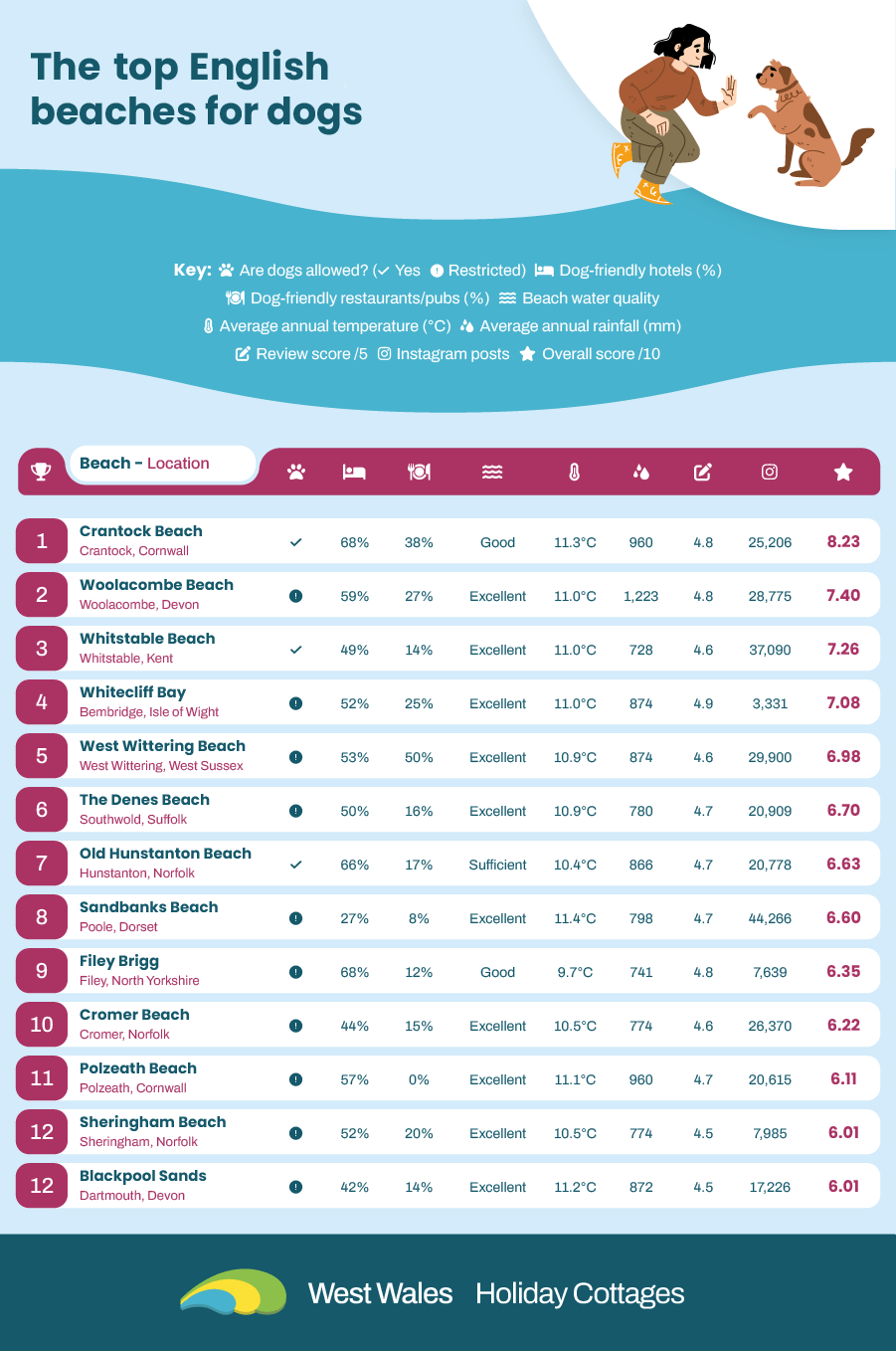
12 tips to keep your dog safe by the coast
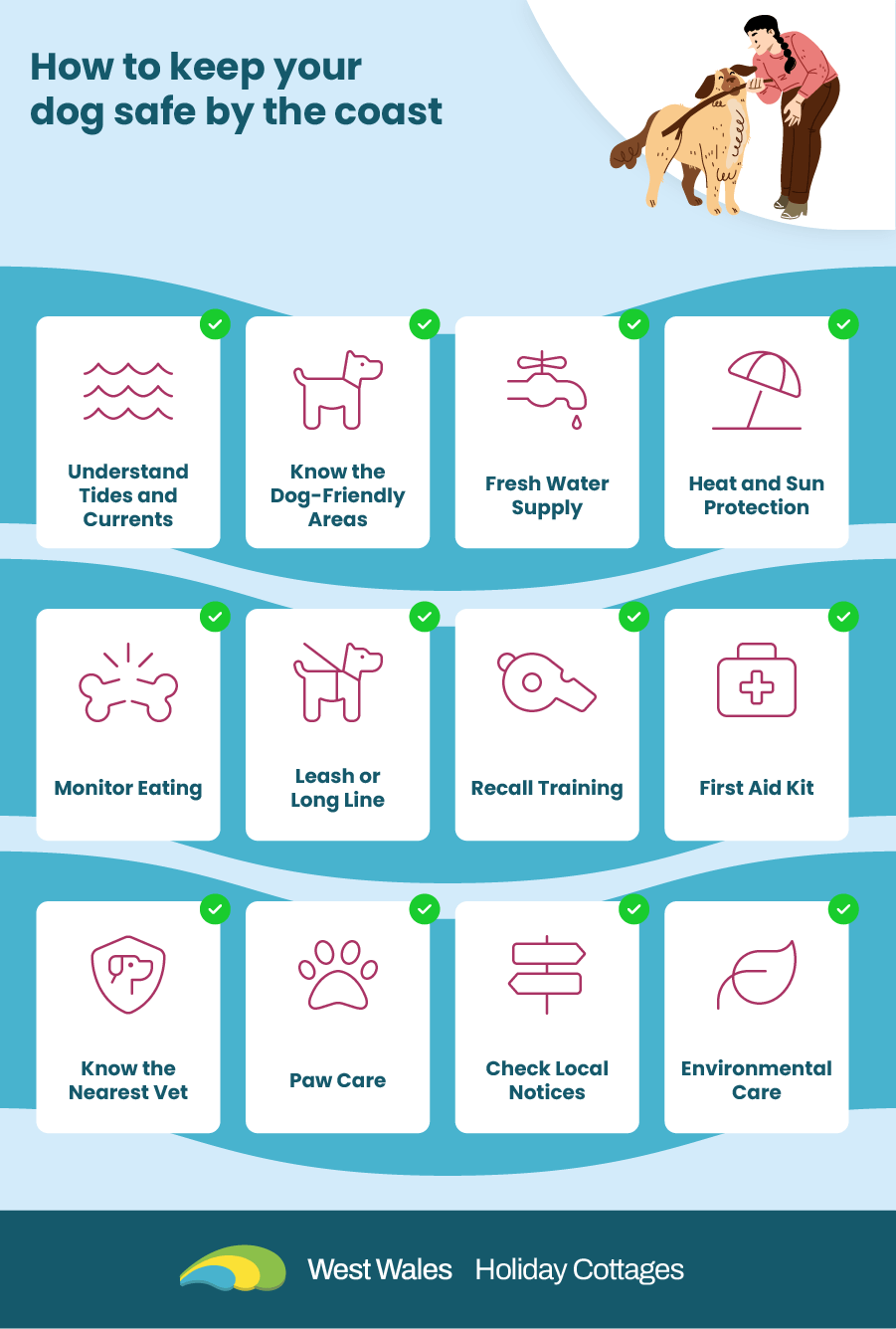
1. Understand Tides and Currents
One of the most overlooked factors when taking your dog to the beach is understanding tides and currents. An incoming tide can rapidly change the dynamics of the shore, making it potentially hazardous for dogs left unattended. Always check the local tide tables before heading out.
2. Know the Dog-Friendly Areas
Not all beaches and coastal areas are dog-friendly. Make sure you are aware of local regulations and permitted zones where your dog can roam freely. Violating these rules can not only attract fines but also endanger local wildlife.
3. Fresh Water Supply
Saltwater is unsafe for dogs to drink and can cause dehydration. Always carry a sufficient supply of fresh water and a bowl for your pet. This is especially crucial on hot days when dehydration can set in quickly.
4. Heat and Sun Protection
While many dogs love basking in the sun, prolonged exposure can lead to sunburn and heatstroke, both of which can be fatal for dogs. Take regular, sheltered breaks with access to plenty of cool drinking water out of the sun to ensure your four-legged friends can regulate their body temperature. If you can avoid a trip to the beach on a hot day, it’s highly recommended.
5. Monitor Eating
Some dogs are inclined to eat things they find on the beach, which can include harmful or toxic substances. Always watch what your dog is sniffing or attempting to ingest.
6. Leash or Long Line
Even if your dog is well-trained, a leash or long line is a good idea near water to ensure you can quickly get control if needed.
7. Recall Training
Work on your dog’s recall skills before going to the coast. This is particularly important as many distractions, such as birds or other dogs, could tempt your pet.
8. First Aid Kit
Always carry a basic pet first aid kit for minor injuries. This should include antiseptics, bandages, and any medication your dog may need.
9. Know the Nearest Vet
In an emergency, knowing the location of the nearest vet can save crucial time. Keep the address and contact details handy.
10. Paw Care
The beach can be harsh on a dog’s paws. Saltwater and sand can cause irritation or even minor cuts. Rinse your dog’s paws with fresh water after your beach visit and check for any signs of injury.
11. Check Local Notices
Often, local authorities post information about water quality, strong currents, or dangerous sea creatures. Always take a moment to read any posted signs or bulletins.
12. Environmental Care
Always clean up after your dog. This keeps the beach enjoyable for everyone and protects local fauna from the risks associated with pet waste.